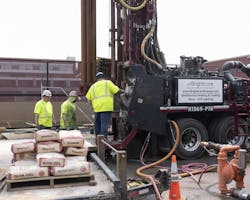Brooklyn College Campus of CUNY Commences Geothermal Test Drilling on Campus
Crews have started drilling a geothermal test well on the campus of Brooklyn College, part of a systemwide plan within the City University of New York to explore viable clean energy options.
Under the partnership with the New York Power Authority (NYPA), through the Decarbonization Leadership Program (DLP), a 500-foot-deep test borehole was drilled to assess the college’s geothermal potential. The program directs NYPA to develop energy and emissions profiles and decarbonization action plans for the state’s carbon-emitting facilities.
“Brooklyn College is proud to play a vital role in advancing clean energy innovation,” said campus President Michelle J. Anderson in a statement. “We thank Governor Hochul for her support of this transformative project, which exemplifies how public-sector leadership, cutting-edge technology, and strategic investment can come together to create lasting change. This initiative stands as a cornerstone of the college’s commitment to building a cleaner, more resilient future.”
Other CUNY institutions developing decarbonization action plans under the DLP include Hunter College and City College. If successful, the projects can show that geothermal energy is capable of replacing fossil fuels in public buildings to reduce emissions, lower energy bills and help the state meet its climate goals.
Funded by a $10 million award from the New York State Bond Act, Brooklyn College’s West End Building (WEB) will be converted to a geothermal heating and cooling system, a clean, renewable alternative offering reportedly 100% carbon-free climate control. The WEB, outfitted with hydronic infrastructure, is an ideal candidate for geothermal integration.
Once operational, the system will not only improve indoor comfort and energy efficiency but also eliminate reliance on traditional fossil fuels. The WEB covers over 20,000 sq ft and includes a 10,000 sq ft computer lab, the Undergraduate Film Department, multimedia classrooms, 16 student clubs, and the Student Testing Center.
The heat factor of the earth’s subterranean core offers the possibility of vast amounts of energy to replace natural gas and fuel coil in combined heat and power applications. A report on geothermal electricity and CHP potential from the European Geothermal Energy Council notes that the overarching heat power of the earth’s crust is close to 12 octillion megajoules.
Of course, only a fraction of that is feasibly available to utilize for human consumption. Harnessing that fraction, however, could prove monumental in creating heat and power without greenhouse gas emissions.
